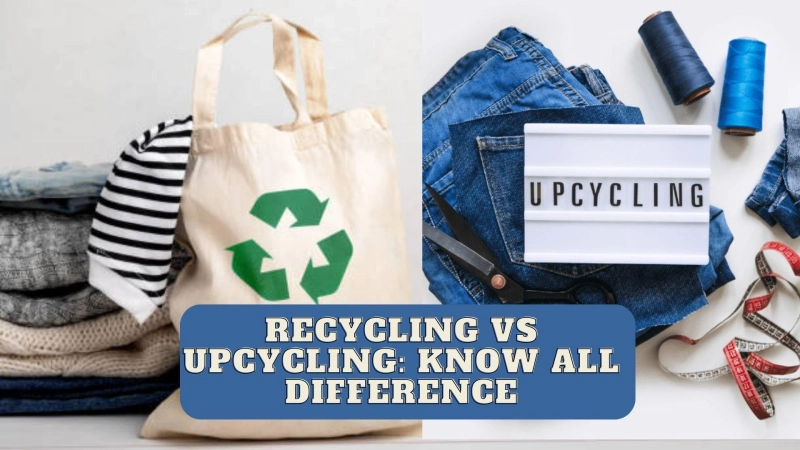The effects of global warming can no longer be ignored. Every little step counts when it comes to saving the planet. Recycling and upcycling are two environmentally friendly practices that can be used to reduce environmental degradation. However, they are not the same thing. In this blog post, we will explore the pros and cons of upcycling vs. recycling and find out which one is better for the environment.
What is Upcycling and Recycling?
Recycling is the process of breaking down waste materials into new products. This process reduces the rate of resource depletion, lessens greenhouse gas emissions, and saves energy. One of the major advantages of recycling is that it creates much-needed jobs, thereby boosting the economy. However, it is not without its disadvantages. Recycling uses a lot of energy, water, and other resources, which can lead to increased carbon emissions if the processes are not properly optimized. Also, the quality of recycled products is not as high as that of new products. For example, recycled paper can only be used a limited number of times before it becomes unusable.
Upcycling, on the other hand, is the process of transforming waste materials into new items of higher quality or value. This process helps to keep waste out of landfills and reduces the demand for new materials. Upcycling has numerous environmental benefits. First, it reduces the need for virgin resources, thereby conserving natural resources. Second, it reduces the amount of waste that ends up in landfills and reduces the need for energy-intensive recycling processes. However, upcycling also has its downsides. It is not always easy to find quality waste materials to upcycle, and it requires a significant amount of artistic skill to transform them into something usable.
Which is Better? – Upcycling or Recycling
The choice between upcycling and recycling ultimately depends on what you want to achieve. If your goal is to reduce the amount of waste in landfills while conserving resources, then upcycling is the better option. However, if your goal is to conserve energy while creating jobs, then recycling is the better choice. In either case, the most important thing is to ensure that the processes are as energy-efficient and sustainable as possible. This can be achieved through the use of efficient production techniques, energy-saving technologies, and sustainable sourcing practices.
Another thing to consider is the market demand for the products you produce. Upcycling is a niche market, meaning that the products created may not always find a ready market. Recycling, on the other hand, has a much broader market, which means that the products created are more likely to sell. However, as with all markets, demand can fluctuate based on many factors such as consumer trends and economic conditions.
Pros and Cons of Upcycling
Pros : One of the biggest advantages of upcycling is that it significantly reduces the amount of waste we produce. Instead of sending items to landfill, upcycling gives them a new life and purpose. This helps to prevent waste and conserves resources. Upcycling also helps to reduce energy consumption and carbon dioxide emissions as it takes less energy to make new items from existing materials than it does to create them from raw materials. Additionally, upcycling promotes creativity, innovation, and individuality.
Cons: One of the downsides of upcycling is that it requires more time and effort compared to recycling. Upcycling is a time-consuming and labor-intensive process, and not everyone has the creativity and skills required to do it effectively. There is also a limit to the materials that can be upcycled as not all products can be repurposed. Lastly, upcycling might not be cost-effective in some cases as it requires more resources and effort than simply buying a new item.
Pros and Cons of Recycling
Pros: One of the most significant benefits of recycling is that it significantly reduces the amount of waste we produce. Recycling helps to save resources and reduce pollution by minimizing the need to extract virgin materials from the earth. It also helps to conserve energy as less energy is required to produce new items from recycled materials than from virgin materials. Additionally, recycling creates jobs and supports the economy.
Cons: One of the major drawbacks of recycling is that it is not always environmentally friendly. Recycling requires energy, water, and other resources to collect, transport, and process used materials. This can sometimes result in increased carbon dioxide emissions. Recycling also has limitations as some products cannot be recycled due to contamination or the cost of processing them is too high. Lastly, recycling relies heavily on the public to sort and dispose of waste properly.
Conclusion:
In conclusion, we will explore the advantages and disadvantages of upcycling vs recycling. The most important thing is to choose the option that best suits your goals and the specific needs of your business. Whatever option you choose, it's crucial to recognize that even small steps go a long way in preserving our planet. Every individual and business has a role to play in ensuring sustainable development. So, let's all do our part to reduce our impact on the planet.


